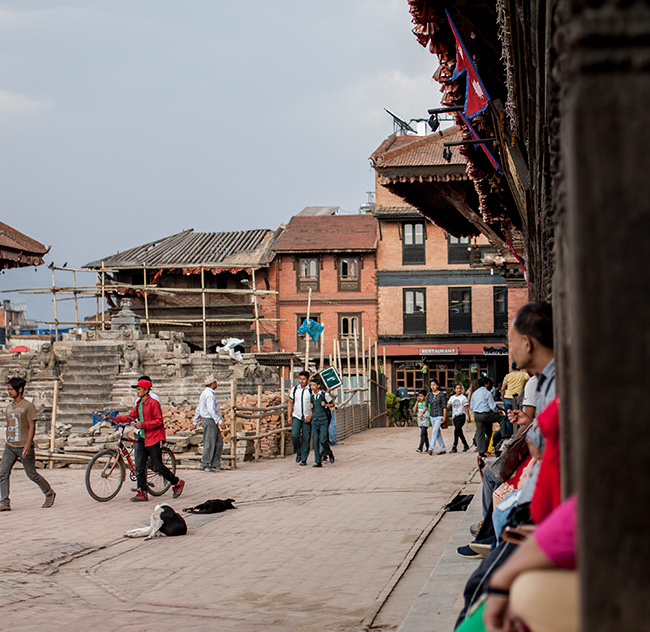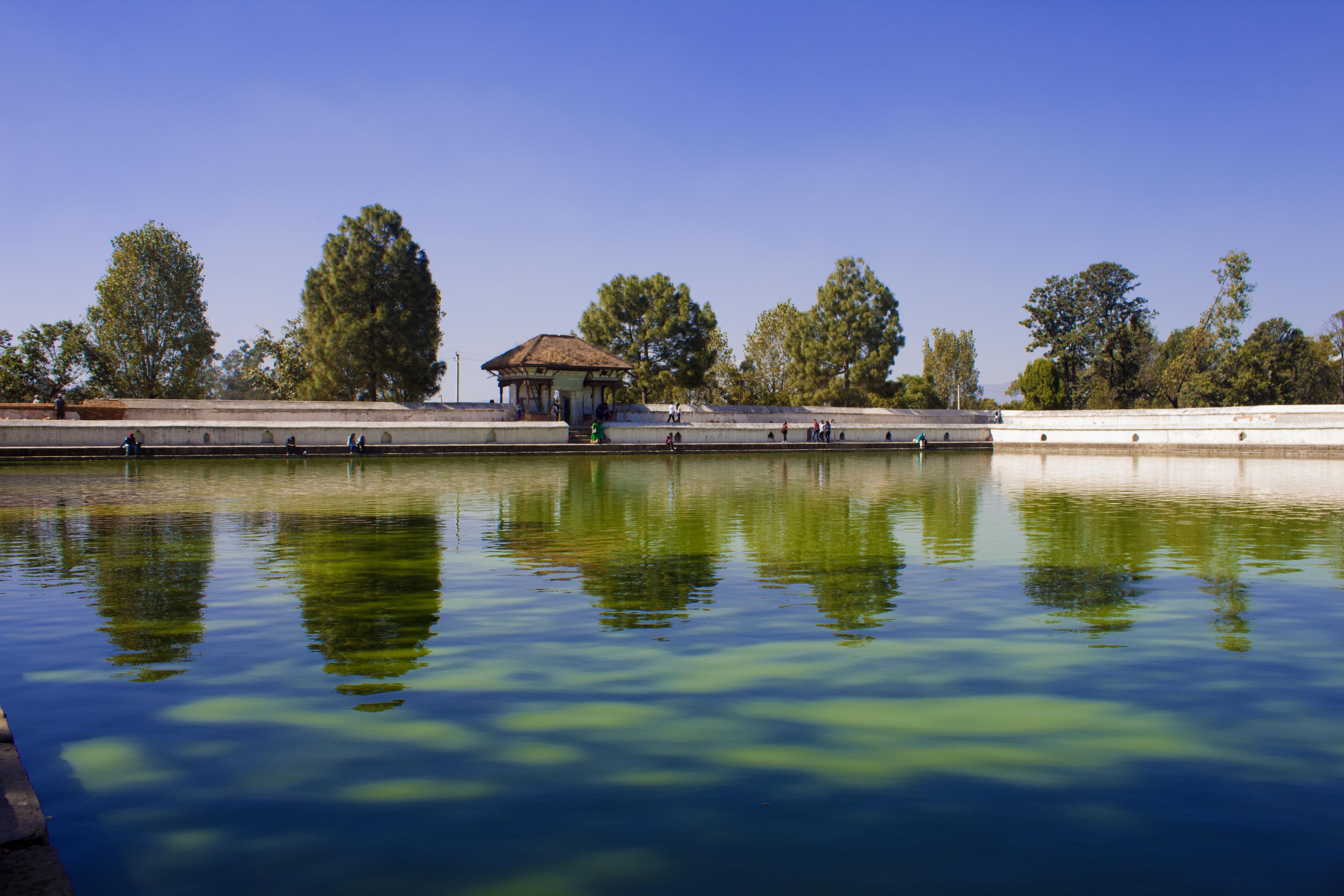It was the large carved wooden window on the façade that made me turn my motorbike around. I didn’t know what the place was—a temple, a pilgrim’s hostel, a residence. I didn’t enter to find out. I just had to see the inside of a building whose front was so artistic.
As I climbed the stone steps to the main entrance I saw an inner courtyard. There was a big oil lamp holder in the middle, unlit, black with soot. Wooden pillars shouldered the weight of two stories. On them, the usual lotus motif. But near their tops were engraved musical instruments: madal and ta, the small brass saucers that when struck together produce the tinkle that punctuates so many Newari devotional hymns. Before I could finish admiring all the pillars a man called to me from the balcony above.
“The goddess is upstairs, brother,” he said, twice, then disappeared. It was cold. I was wearing trekking boots, which take a while to lace up. I had seen the sign at the base of the wooden stairs forbidding people to progress beyond that point wearing shoes. I lingered in the courtyard, but gave in after a while and went up.
The first floor could have been the first floor of any temple anywhere in the Kathmandu Valley: signs of a family occupying a room or two, a vermilion and soot-coated metal donations box, a cluster of bells, niches and a clock on the wall. No amount of temple-hopping could have prepared me for the next sight. Stepping into the inner sanctum was time travel. It was dark save for five or six oil lamps and a couple of lances of sunlight coming in through a latticed window. The floor was a tarry rug of soot and oil. Besides the silence and the darkness, there were the huge masks of the nine goddesses, Nava Durga, staring at you from the wall. I learned about the masks from a woman tending to the goddesses’ shrine. She directed me to the man who had called me upstairs. He told me that electric lights were forbidden in the sanctum. That is why he insisted on donations, he explained. It was to buy oil for the lamps.
I left the temple, head abuzz from being in a place so palpably powerful. I had stumbled into one of Bhaktapur’s gems. I also remembered how on the notice for visitors to take off their shoes at the base of the stairway there was an advertisement for a computer programming institute. That dual reminder – need to go barefoot and a place to learn programming in – is characteristic of the multi-faceted avatar that is Bhaktapur.

Like any ancient city that has managed to salvage its heritage, Bhaktapur is a tourist magnet. To woo tourists it has had to become touristy. However, that layer is thin. Bhaktapur’s uniqueness is its duality: an ancient city within a tourist hub. It’s an ingeniously designed false front of modernism, with a fastness of culture and tradition behind.
For you can be in a frenetic square teeming with tourists, peddlers, worshippers, guides and schoolchildren one minute and the next, wandering down an alley, in a square lined with drying laundry, elderly women basking their tattooed legs in the winter sun, giggling as they twirl out lamp wicks from cotton wool. You ask them something in Nepali and they reply in Newari, then shake their heads to convey that they don’t speak Nepali before bursting into giggles.
The 2015 earthquake was a huge blow to Bhaktapur’s heritage. Darbar Square is being rebuilt, magnificent temples now mere plinths. Concrete, sand, and bricks choke narrow alleys. Entire neighbourhoods are sprouting concrete houses. Doubtless, the sight pains those who remember adobe houses and tiled roofs. At least there is consolation in Bhaktapur. There are still concrete-free neighbourhoods. On a winter’s day, walking around an algae-green pond with a gilded serpent head emerging from its centre, it seems heritage has a chance, a home, here.
A touristy place is as much about sites worth visiting as scenes of enterprising people making a living out of those sites: handicrafts, guided tours, local delicacies. Away from the curio shops and street peddlers, Bhaktapur folk maintain a more languid way of doing business. Like the man selling mustard oil. Canisters hung on either end of the bamboo pole he carried on his shoulders. He went from door to door, singing his way through alleys, his songs melodious utterances of names of Hindu gods. “Jai Kaali! Narayan!” He sat on doorways, pouring out the oil with an old Horlicks glass jar. In another square, as people chatted in the warm winter sun, a man walked by with radishes in a doko: twenty rupees a bunch, leaves still wet with dew, tubers caked with earth. You don’t go vegetable shopping in certain nooks of Bhaktapur; you simply warm yourself in the sun and wait for farmers hauling produce in baskets to walk by.
Bhaktapur’s social fabric is best seen in the winter sun. The coveted warmth brings life – communal life at least – out onto the streets and squares. It’s a fantastic bargain for a visitor: walk and you get a glimpse of the city’s heart. Walk into any alley, nameless and too banal to be on a city guide. Saunter into decrepit courtyards. Examine a dilapidated pati. Every square deserves a look. The further you wander from the famous squares the better. There is a good chance taking a chance will reveal something memorable.
It happened to me recently. I went down a steep alley choked with sand and bricks and arrived at a place where a motor road intersection, a corner of a public square and a shrine converged.
A small group of men, aged early forties to late sixties, was sitting in a ‘U’ formation below a platform that was a Ganesh shrine. A headless goat lay on the flagstone. Two men were cutting a sliver from its neck. Around the blood doused Ganesh statue was a garland of inflated goat intestine, at his feet dozens of eggs dyed in blood. A man performed rituals at the shrine while the group sang, reciting from two yellow-painted manuscripts to the accompaniment of a drum and cymbals. To minds accustomed to concepts of propriety and boundaries, there was a spectacle that blurred everything: a puja done sitting on a road with motorbikes zipping by; devotional songs and blood; a garland of flesh!
Struck by the novelty of the scene (I hadn’t known until then that animals were sacrificed at Ganesh temples) I decided to leave no alley unexplored. I walked an alley parallel to the one I had come down on and arrived at another temple. Its walls were streaked with cracks from the earthquake. No devotional songs, no devotees. Only a Bollywood song played fortissimo, and the whining of an electric saw. Yet in all probability, the wood was being sliced to fashion a beam to renovate the same temple.
After a couple of hours of aimless weaving in and out of Bhaktapur’s sun-deprived alleys and sauntering around its sunny squares, it began to look more and more like a mandala. Not the kind depicted on canvas, crammed with paradisaical scenes of hamlets with pagoda temples scattered along a milky white river flowing out of snowy mountains. Bhaktapur is a febrile mix: medieval and modern, devotional and pop songs, agrarian and touristy, communal and commercial. It is like that temple, glazed bricks and newly carved wooden windows outside; oil-lamps-only sanctum inside.

The religious and secular don’t have boundaries in Bhaktapur. Doorways have shrines above it or at the very least an image or a god’s name hand-painted over lintels. Most homes offer flowers, rice grains and vermilion to the bass relief stone lotuses they have placed on the street directly outside their doors. The sacred is everywhere. And every place also has a functional aspect. It’s a space, to be filled with life. It’s a place to chat with friends, winnow grains, dry radish leaves for making sauerkraut, a place to walk to with your wife of six decades, offering flowers and vermilion to a deity like you have done all your life. It’s where heritage is made human.
While in Bhaktapur

Squares
Squares are almost synonymous with Bhaktapur. Clichéd though it may be, a visit to the three main squares – Darbar, Taumadhi and Dattatreya – is highly recommended. The smart thing to do is not limit yourself to these sites but explore. After taking in the marvel that is the Nyatapola Temple, head south on the main street from Taumadhi Square to watch Bhaktapur’s renowned potters at work in the Potters Square. Head to Dattatreya, the smallest of the three squares, to see what is perhaps the most imitated window design in Nepal: the Peacock Window.
Alleys and Shrines
The entire strip north of Dattatreya Square, running east to west, is a vast treasure trove if you like discovering places rather than have guidebooks select them for you. There are countless comparatively unknown temples, squares and courtyards here.
Siddha Pokhari
This large pond is the perfect anecdote to the kerfuffle of Bhaktapur’s tourist sites. It’s best to leave this for the last part of the day.
Delicacies
Bara
One of the best places to try bara in Bhaktapur is a small eatery on the lane that opens on the north face of the Nyatapola Temple. You will need to look for this place carefully. They don’t have a huge signboard advertising themselves, which is often a sign that the place is famous for its food.
Juju Dhau
Even Kathmandu has shops declaring themselves as the best makers of Juju Dhau, or King of Yogurts. But the best juju dhau, of course, comes from Bhaktapur. Take the alley at the southwestern corner of Dattatreya Square, the one that passes along a sunken bath. You will get to a small shop selling one of the best yogurts in the city.
From the archive




















